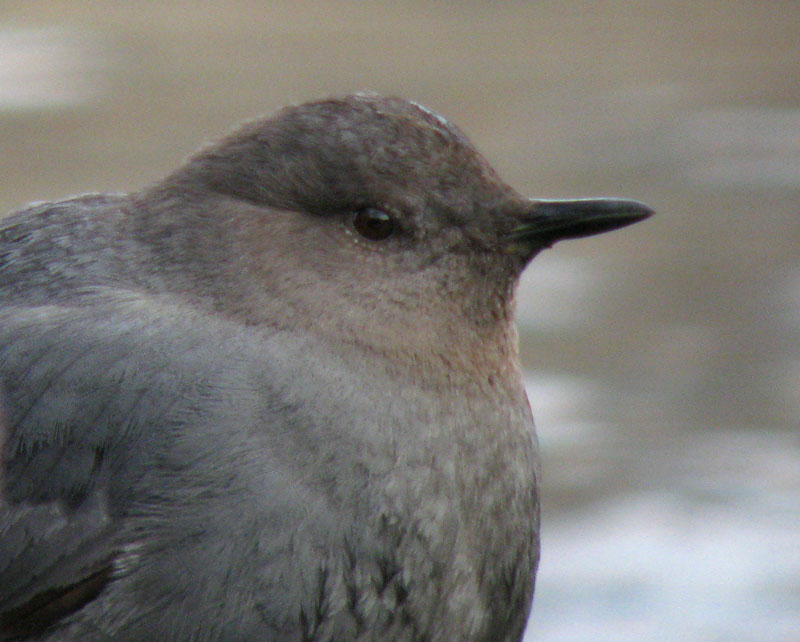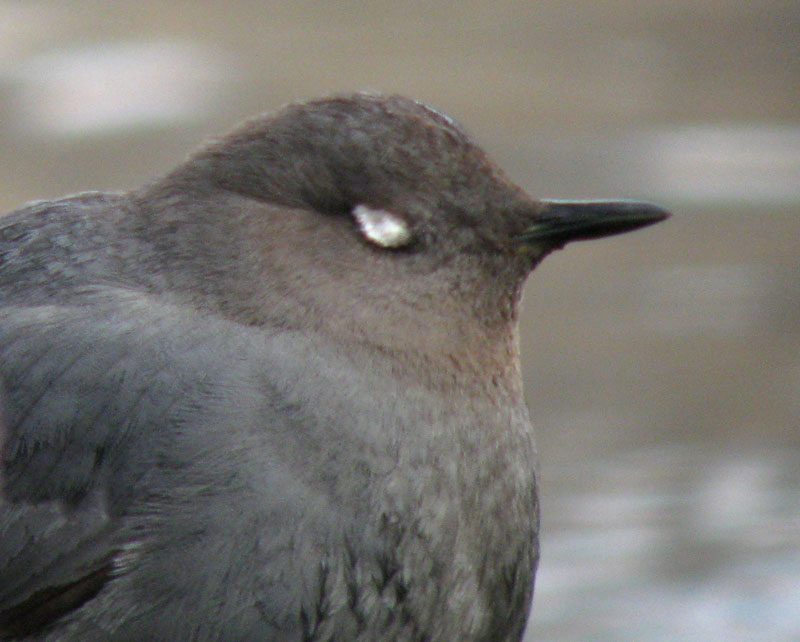

It’s one of the first things people notice when they get a good look at a Dipper – the eyelid flashes white when it blinks! This is so different from any other bird that it begs for an explanation. Understandably, many people assume that the flashing white eyelid must have something to do with the dipper’s unusual underwater habits, related to helping them see underwater, which leads to the common misconception that the white flash is a nictitating membrane.
All birds have a nictitating membrane, a translucent whitish/bluish “third eyelid” that flicks across the surface of the eye from front to back to protect it while still allowing some vision (more info on Wikipedia).
But the dipper’s flash is bright white, and travels from top to bottom and back up (and if you can examine it very closely you’ll see that it’s covered with tiny white feathers). It is the eyelid.
Because the eyelid is white, we notice every time a dipper blinks. They don’t blink a lot more than other birds, it’s just that most other birds have dark grayish eyelids without feathers, and blink more quickly, so their blinking is barely noticeable.
The next question is… Why? Why do dippers have white eyelids and then make a big show of blinking slowly? Nobody knows.
One idea that’s been proposed is that it’s a useful way of communicating with other dippers in the very noisy streamside environment, but that’s just a general idea about visual communication and doesn’t get any closer to explaining what dippers are trying to say with their eyelids. Even the authoritative BNA account by Willson and Kingery offers no explanation.
Maybe the dippers we see – blinking as they pop in and out of the water – are just blinking, and the white eyelid has some other specialized function at another time in their life. It’s a basic question about a relatively common and easy-to-see bird, and it could be answered by just observing and getting to know some dippers. And that seems like it would be a pretty nice way to spend a few months.
References
Willson, Mary F. and Hugh E. Kingery. 2011. American Dipper (Cinclus mexicanus), The Birds of North America Online (A. Poole, Ed.). Ithaca: Cornell Lab of Ornithology; Retrieved from the Birds of North America Online: [subscription required] http://bna.birds.cornell.edu/bna/species/229


Hi David,
Beautiful photos of that Dipper!You really captured not only the nictating eyelid, but also the bird’s personality.
I don’t know if you’ve seen this or not, but I posted a comment to your entry about the foraging behavior of juncos. We (finally!) had an influx of juncos here, and it’s been a treat watching them. I took some video, in case you’d be interested in seeing it.
Best to you–
John C. Rumm
Cody, Wyoming
Hi John, Thanks for the comment, and for the great day of birding there (with dippers!). I would definitely be interested in seeing the junco video. I’ll send you an email.
Best, David
Wonderful timing on capturing the blink to share the white eyelid!
Perhaps the colored eyelid is useful while feeding below the water’s surface? I couldn’t help but wonder if it is somehow used as an attractant to draw prey closer? Just an idea and not one based on any given theory or prior knowledge of the species and its known feeding habits.
Very interesting. I wonder if the other dipper species share this feature? Or other birds of fast-flowing river habitats . . . (e.g. Torrent Tyrannulet of Tropical America)
The Bat Hawk (which occurs here in Africa, as well as in SE Asia) also has white eyelids (although I suspect that they are bare-skinned, not feathered). This highly specialized raptor hunts at dusk, and habitually roosts by day on open, horizontal branches of pale-barked trees. When it dozes off, the closed white eyelids give the impression that it is awake and not actually sleeping, so I expect that it may be an anti-predator device. Larger diurnal raptors – such as the African Crowned Eagle – might otherwise be tempted to snatch a sleeping Bat Hawk from its perch. . . .
I can email you photographs if you like?
Thanks for your fascinating website and your marvelous books!
Duncan Butchart, Nelspruit, South Africa
Me again. I’ve just spent a few minutes scrolling through photographs of Brown Dipper and White-throated Dipper on google images, and came across a pic of each species in which the white eyelids are obvious. So, it seems to be a family trait which is not unexpected.
Hi David,
I was watching a french documentary not too long ago about the avifauna of France, and they showed a Common Shelduck that had the same white eyelid. The explanation they proposed was that when the birds are younger, and more vulnerable, this serves as a means of protection. Supposedly, the white eyelids would make a possible predator think they’re open, ruining the surprise attack. Perhaps this logic also applies to the American Dipper? To protect the younger birds from possible predators?
Cédric Duhalde (17),
Pacifica, California
Hi Cédric,
Thanks very much for passing that along. It’s an interesting idea, and also good to know that Common Shelduck shares the white eyelid, which might offer some new avenue for investigation.
Pingback: Birding the Fenland Nature Trail – Prairie Birder
Pingback: The Great Dipper Show | Eiwawar
Pingback: The lost waterfall, ammonites & an American Dipper | FOSSILS & FAUNA
I had a very cooperative American Dipper in Waterton National Park, Alberta, Canada. The Dipper took a break while foraging for aquatic insects in its stream giving me the opportunity to get some good shots of it and its white eyelid.
Here is a link to the photos:
https://drive.google.com/file/d/1_vIn-My-yXRqcKM-3xxWO7jx-m3K_g97/view?usp=sharing
Let me know if you would like some videos of the Dipper foraging along the stream.
Pingback: Meet the Dipper, the Songbird That Swims – Madisens Science
Pingback: Meet the Dipper, the Songbird That Swims – WordPress Website
Pingback: Meet the Dipper, the Songbird That Swims – Science
Pingback: Meet the Dipper, the Songbird That Swims – Recruitment
Pingback: BACKYARD BIRDING IN MERIDA, YUCATAN AND BEYOND – WHAT’S THE EYE-DEAL? EYELIDS AND EYE-RINGS, PART 1 of 2 - The Riviera Maya Times
In my observations of dipper nests over the course of three breeding seasons, I have noticed that when an adult is sitting on eggs or keeping nestlings warm, the adult disappears in the shadows except when blinking. I’ve observed a mate flying by or stopping briefly on the “launching rock” below the nest just as the adult in the nest blinked. It seems like the white eyelid could be an efficient way to let a mate (or a predator) know that an adult has the babies covered. Since the birds have to blink anyway, the message wouldn’t require an extra expenditure of energy. It would also be less likely to attract attention to the location of the nest than a vocal message would.
—Kate Marianchild
Author of Secrets of the Oak Woodlands: Plants and Animals Among California’s Oaks